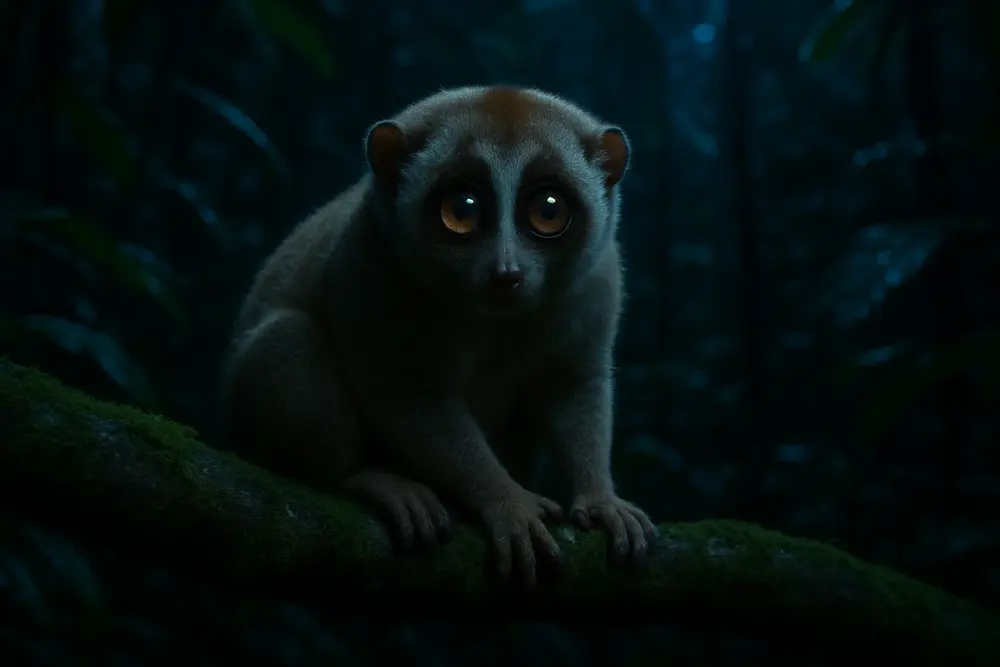People searching for "loris animal" are often drawn by curiosity and the unique appearance of this small, wide-eyed primate. Their search intent may include:
General information and identification
Understanding behavior and habitat
Discovering why lorises are considered venomous
Exploring their role in ecosystems
Concerns about conservation status and illegal pet trade
Clarifying myths vs. facts about slow lorises on social media
This article presents a comprehensive, science-backed, and ethically informed deep dive into the world of lorises.

Lorises are small, nocturnal primates in the family Lorisidae. The term "loris" refers to two main groups:
Slender lorises (Loris genus): Native to India and Sri Lanka
Slow lorises (Nycticebus genus): Found throughout Southeast Asia
They belong to the primate suborder Strepsirrhini, which also includes lemurs and galagos.
Large forward-facing eyes for night vision
Grasping hands and feet with opposable thumbs
Short or absent tails
Facial markings and soft, dense fur
Movement: Slow, deliberate, and silent
Lorises have highly developed tapetum lucidum (a reflective eye layer) that enhances their night vision, crucial for hunting insects and navigating trees in darkness.
One of the only venomous mammals, the slow loris produces toxins from a gland in its upper arm. When mixed with saliva, it becomes a venomous secretion used for:
Defense against predators
Intra-species competition
Protecting offspring
Their slow, cautious locomotion makes them hard to detect by predators. They freeze when startled and move with precision through the canopy.
Slow lorises are found in:
Indonesia (Sumatra, Java, Borneo)
Thailand
Malaysia
Cambodia
Vietnam
Slender lorises are limited to:
Southern India
Sri Lanka
Lorises thrive in tropical rainforests, bamboo groves, and plantations. They are arboreal and rarely descend to the ground.
Lorises are opportunistic feeders. Their diet includes:
Insects and small vertebrates (geckos, birds)
Gum and sap from trees
Nectar and fruit
They have a toothcomb (a set of lower incisors and canines) used for grooming and scraping gum from bark.
Lorises are generally solitary except during mating or when mothers are raising offspring. They use scent marking to define territory.
While generally quiet, lorises emit high-pitched calls for:
Mating
Warning signals
Mother-offspring interaction
Gestation: ~5-6 months
Litter size: Usually 1-2 infants
Infant parking: Mothers leave babies hidden while foraging, a behavior rare among primates
Habitat loss due to logging, agriculture, and development
Illegal wildlife trade for exotic pets and traditional medicine
Capture for tourism photos, often with teeth removed cruelly
Most loris species are listed as either Vulnerable, Endangered, or Critically Endangered. Examples:
Javan slow loris (Nycticebus javanicus): Critically Endangered
Bengal slow loris (Nycticebus bengalensis): Vulnerable
CITES Appendix I: Bans international trade
National laws in India, Indonesia, and other countries
Videos showing lorises being tickled or held as pets are widespread. These clips may appear cute but often mask:
Stress and discomfort
Illegally trafficked animals
Misinformation about their suitability as pets
In parts of Southeast Asia, loris body parts are used in folk medicine for asthma, spiritual protection, or as aphrodisiacs—contributing to poaching.
Lorises are wild animals with complex needs. In captivity, they suffer from:
Malnutrition
Psychological stress
Respiratory issues from improper environments
To prevent venomous bites, traffickers often clip or pull their teeth, a painful, disfiguring, and sometimes fatal act.
Organizations like:
International Animal Rescue
Little Fireface Project
Wildlife Friends Foundation Thailand (WFFT)
work to rehabilitate rescued lorises and raise awareness.
Never buy lorises or support exotic pet trade
Report illegal wildlife sales
Support conservation NGOs
Educate others about the true needs of lorises
The loris, with its big eyes and quiet ways, is an evolutionary wonder and ecological treasure. But behind its popularity lies a dark reality of exploitation and decline. By understanding its biology, respecting its needs, and supporting ethical conservation, we can help ensure a future where this unique primate thrives in the wild—where it belongs.
animal tags: loris animal
We created this article in conjunction with AI technology, then made sure it was fact-checked and edited by a Animals Top editor.